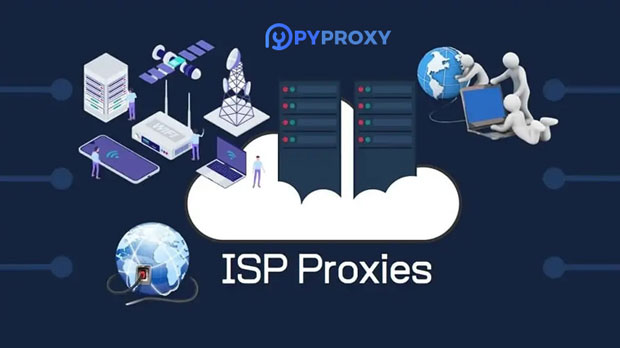In today's digital landscape, static proxies have become an essential tool for businesses and individuals seeking privacy, security, and seamless internet access. Whether you're performing web scraping, conducting market research, or simply protecting your online presence, selecting the right proxy provider is crucial. Among the many options available, PYPROXY and CroxyProxy stand out as two of the most popular choices. This article will delve deep into the features, reliability, and overall user experience of these two static proxy providers to determine which one offers superior performance. We will explore their pros and cons, helping you make an informed decision for your proxy needs. Introduction to Static ProxiesStatic proxies are dedicated IP addresses assigned to users for extended periods of time. Unlike rotating proxies, where the IP changes frequently, static proxies remain the same, making them ideal for tasks that require consistent and stable connections. They are particularly beneficial for businesses and individuals who need to perform web scraping, social media management, and other tasks requiring long-term access to certain websites without triggering security systems that may block frequent IP changes.The key advantage of using a static proxy is its reliability. When you need uninterrupted access to a website over time, a static IP ensures that your connection remains stable, minimizing disruptions. The challenge, however, lies in selecting the right static proxy provider. Among the myriad of services available, PyProxy and CroxyProxy are two popular options. In this article, we will compare these two services based on several key criteria, including reliability, speed, customer support, and ease of use.1. Overview of PyProxyPyProxy is known for its efficient and customizable static proxy services. It offers a wide range of proxy ips that are stable and perfect for long-term use. The service focuses on providing high-quality proxies that can handle tasks such as web scraping, ad verification, and data gathering without being easily blocked or flagged by target websites. PyProxy’s extensive network of proxies ensures that users can maintain access to resources without frequent disruptions.1.1 Key Features of PyProxy- Stable Connection: PyProxy offers consistent and reliable connections, making it ideal for tasks requiring a long-lasting IP address.- Customization Options: PyProxy allows users to choose their IP locations, providing flexibility for geo-targeting and avoiding geographical restrictions.- Strong Security: With a focus on privacy, PyProxy offers high-security features to ensure that data remains protected.- Reliable Support: PyProxy provides 24/7 customer support, ensuring that users can get help whenever needed.1.2 Pros of PyProxy- Long-term Stability: As a static proxy provider, PyProxy’s IPs are perfect for users who need consistent and uninterrupted access.- High-Quality IPs: The IPs offered are less likely to be blocked or flagged by websites, making them a reliable option for web scraping and similar tasks.- Customizable Options: Users can select specific locations for their proxies, allowing them to target specific regions or countries.1.3 Cons of PyProxy- Higher Cost: While PyProxy offers excellent quality, its services come at a higher price point compared to other proxy providers.- Limited Locations: Although PyProxy offers a decent number of IP locations, it may not cover as many global regions as some competitors.2. Overview of CroxyProxyCroxyProxy, on the other hand, provides a simple and user-friendly static proxy service. It is particularly known for its easy-to-use interface, making it an excellent choice for users who are new to proxy services. While CroxyProxy offers reliable connections, it is typically more affordable compared to premium options like PyProxy. This makes it an attractive choice for individuals or smaller businesses that need to save on costs but still require decent proxy performance.2.1 Key Features of CroxyProxy- User-Friendly Interface: CroxyProxy is easy to set up and use, making it accessible to users with minimal technical knowledge.- Affordable Pricing: One of the main selling points of CroxyProxy is its cost-effectiveness, making it a viable option for budget-conscious users.- Decent Speed: CroxyProxy provides relatively good speed, ensuring that users can browse the web or perform tasks without noticeable delays.2.2 Pros of CroxyProxy- Cost-Effective: CroxyProxy offers affordable pricing plans, making it an excellent choice for budget-conscious individuals or small businesses.- Ease of Use: The platform is designed to be simple and intuitive, making it ideal for those who are new to using proxy services.- Decent Performance: CroxyProxy performs well in terms of speed and reliability, particularly for lighter tasks.2.3 Cons of CroxyProxy- Limited Customization: Unlike PyProxy, CroxyProxy offers fewer customization options, limiting flexibility for users with specific needs.- Occasional Speed Drops: While generally reliable, CroxyProxy can experience occasional speed drops, which may affect performance for more demanding tasks.- Less Secure: CroxyProxy’s security features are not as robust as those of premium providers, which could be a concern for users handling sensitive data.3. Reliability Comparison: PyProxy vs CroxyProxyWhen it comes to reliability, both PyProxy and CroxyProxy have their strengths and weaknesses. PyProxy is undoubtedly more reliable in terms of long-term stability and performance. Its dedicated static proxies ensure uninterrupted access to websites, making it the top choice for users who need consistent, high-quality proxies. The added benefit of customizable IP locations makes PyProxy a better choice for users who need to bypass geographic restrictions.On the other hand, CroxyProxy offers solid performance at a lower price point. While it may not be as stable as PyProxy for heavy tasks like web scraping, it is still a reliable option for lighter use cases. CroxyProxy's affordability and ease of use make it a good choice for individuals or small businesses with less demanding needs.4. Speed and Performance: Which One Wins?In terms of speed, both PyProxy and CroxyProxy provide decent performance. However, PyProxy takes the lead when it comes to maintaining consistent speeds during long sessions. For web scraping and data-intensive tasks, PyProxy ensures that users experience minimal latency and no interruptions. CroxyProxy, while generally fast, can experience occasional slowdowns, particularly during high-demand periods.5. Customer Support: PyProxy vs CroxyProxyCustomer support is an essential factor in choosing a proxy provider. PyProxy excels in this area, offering 24/7 support to ensure that users can resolve issues quickly. CroxyProxy, while offering customer support, does not provide the same level of responsiveness or availability. This could be a significant factor for users who require immediate assistance with their proxy services.6. Conclusion: Which Proxy Provider is More Reliable?In conclusion, PyProxy emerges as the more reliable option for users seeking stable and high-performance static proxies. While it comes at a higher cost, its consistent speeds, high-quality IPs, and customizable options make it an excellent choice for demanding tasks. On the other hand, CroxyProxy is a more affordable option suitable for users with lighter needs. While it may not offer the same level of reliability or security as PyProxy, it remains a strong contender for budget-conscious users.Ultimately, the choice between PyProxy and CroxyProxy comes down to your specific needs and budget. If reliability, stability, and customization are top priorities, PyProxy is the clear winner. However, if you need a cost-effective solution for lighter tasks, CroxyProxy can be a solid choice.
Sep 08, 2025

































































